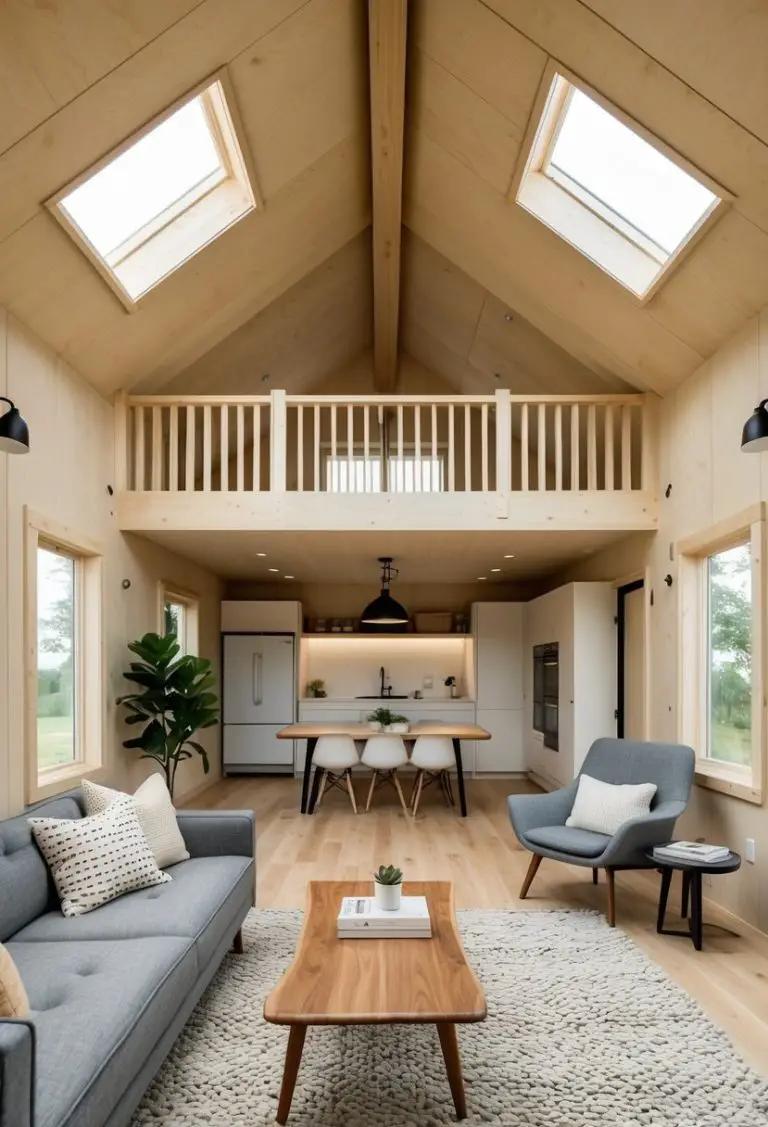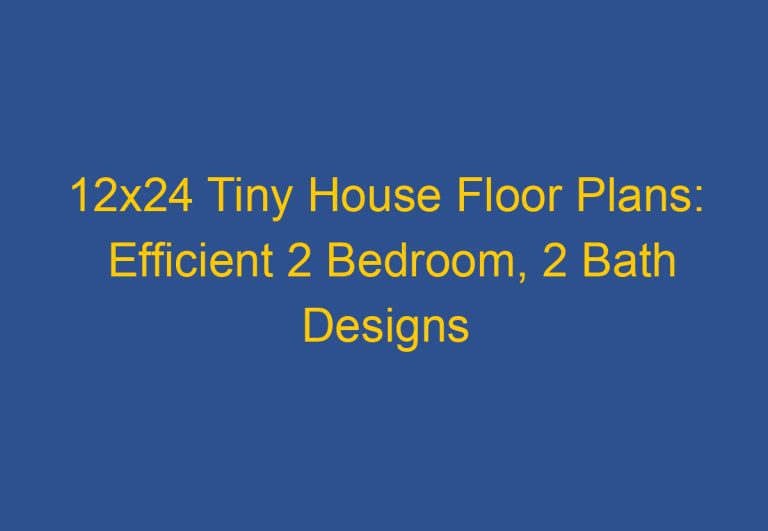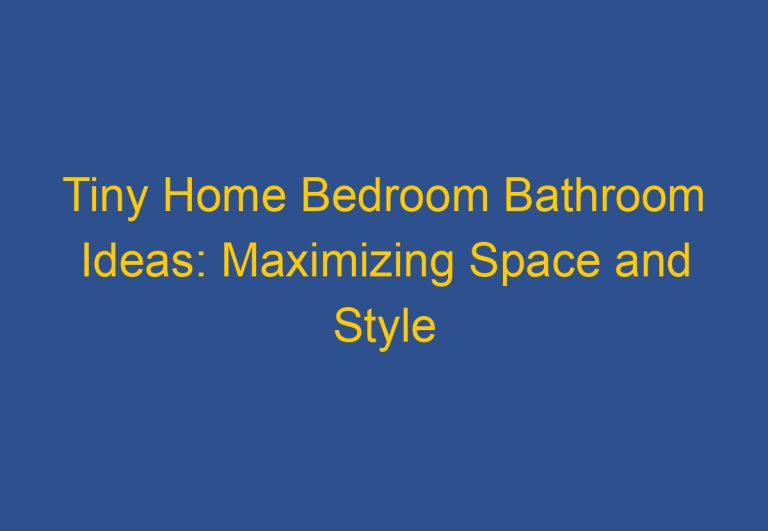Tiny Houses That’ll Have You Trying to Move in ASAP: A Look at the Most Cozy and Compact Homes
The tiny house movement has been gaining traction in recent years, with more and more people opting for smaller living spaces. These tiny homes are often less than 500 square feet and can be built on wheels or a foundation. They offer a simpler way of life, with less space to clean and maintain, and are often more affordable than traditional homes.
Despite their small size, tiny houses can be designed to be functional and stylish. Many tiny homes come equipped with all the amenities of a larger house, including a kitchen, bathroom, and bedroom. Some even have outdoor living spaces, like porches or decks. With the right design, a tiny house can feel spacious and comfortable.
Modern Farmhouse
This 1,000-square-foot farmhouse underwent a complete renovation to give it a modern edge while retaining its original charm. The exterior features a new galvanized metal roof that adds a contemporary feel to the simple white structure. Inside, white shiplap walls and restored wood floors create a warm and inviting ambiance. The highlight of the house is the 98-square-foot galley kitchen with its canary yellow cabinetry. The farmhouse is a perfect example of how modern design can be blended with traditional architecture to create a stunning home.
Converted Schoolhouse
Designers John Loecke and Jason Oliver Nixon of Madcap Cottage converted an 1840s schoolhouse into a tiny home in upstate New York. The 858 square feet home features at least a dozen paint colors, patterned fabrics and wallpapers, and ample antiques behind its No. 2 pencil-colored door. The schoolhouse is a mobile park model and is a perfect example of how creative design can transform an old building into a beautiful and functional living space. Visitors can take a tour of this unique and charming home.
Restored Folk Victorian
The Duckworth family’s restored Folk Victorian cottage is a dreamy 635-square-foot tiny home. The petite front porch adds to its inviting charm, while the vintage mint-colored enamel range in the wallpaper-clad kitchen adds a touch of nostalgia. The cottage features a two-room layout and has been transformed from a potential wrecking ball victim to a cozy, livable space. The stairs in this restored Folk Victorian cottage are likely compact and space-saving, fitting with the tiny home design.
Converted Boathouse
Designer Gary McBournie took advantage of the unique “lot” options when building this 880 square foot converted boathouse. To maximize the limited space, McBournie incorporated clever space-saving design ideas, such as wall sconces instead of lamps and a built-in banquette for seating. The result is a cozy and functional living space that utilizes every inch of the small footprint.
Buccolic Cottage
The bucolic cottage is a small and cozy dwelling that retains its original architecture while incorporating modern furnishings and a fresh color palette. With only 700 square feet of living space, the cottage is a testament to the tiny house movement and proves that small living can be stylish and functional.
The exterior of the cottage features clapboard siding and a pitched roof, giving it a classic and timeless look. Inside, the cottage boasts Shaker-front cabinetry, which adds a touch of rustic charm to the space. The color palette is light and airy, with whites and soft blues dominating the decor.
One of the standout features of the bucolic cottage is its clever use of space. The cottage has an open floor plan that maximizes every inch of the living area. The living room seamlessly flows into the kitchen, which is equipped with all the modern appliances needed to cook a gourmet meal. The bedroom is cozy yet comfortable, with a plush bed and plenty of natural light.
Overall, the bucolic cottage is a charming and inviting space that proves that small living can be both stylish and functional. It’s the perfect retreat for anyone looking to simplify their life and embrace the tiny house movement.
Cozy Lake House
Abby and Joe Albers transformed their 800-square-foot Michigan lake cottage into a charming and nostalgic retreat. The interior features white walls that create an open and airy atmosphere, while also providing a clean canvas for Abby’s camp-style vintage collections. The cozy lake house is a perfect example of how to make the most of a small space without sacrificing style or comfort. Visitors can take a tour of the property to see the creative use of space and the carefully curated decor.
Rustic Retreat
Designed by architect Bobby McAlpine, this cozy rural retreat was created as a seamless transition from the surrounding countryside to the interior. The natural materials and warm, woodsy palette used in the design give the tiny home a rustic feel. The open floor plan includes a tucked-in bed nook and a small, yet well-appointed kitchen. This tiny home is a perfect escape for those seeking a peaceful retreat in the countryside.
Antiques-Filled Bungalow
Bambi and Frank Costanzo’s 1920s bungalow is a cozy and charming space filled with antiques. The house, which measures only 996 square feet, features a handsome dark exterior that contrasts beautifully with the towering sycamore trees surrounding it. The front porch, which originally spanned the entire length of the house, was partially co-opted by Bambi to create extra space for a new library. Visitors can take a tour of the bungalow to see the unique collection of antiques that Bambi and Frank have gathered over the years.
Grain Silo Guest House
Antiques dealer Amy Kleinwachter’s 1,000-square-foot guesthouse is a one-of-a-kind creation. She transformed a 14-foot-round grain silo into a quirky and cozy living space. The guesthouse features numerous salvaged materials such as weathered beadboard, sheet metal, window frames, and an old metal awning. Visitors can take a tour of this unique space and admire the creativity and resourcefulness that went into its construction.
Open Air Living Room
This tiny home concept by Reclaimed Space is perfect for those who want to experience indoor/outdoor living. The butterfly structure of the home is designed to forgo walls and windows, allowing for an open-to-the-elements approach. The open-air kitchen and living room are located under the metal roof structure and come equipped with a big screen for movie nights. The vintage Airstream provides the sleeping quarters, while a full bath sits in the middle. The open-air living room allows for a unique and refreshing living experience, making it perfect for those who enjoy nature.
Coastal Cottage
Coastal cottages are known for their small size and charming character. Designer Jennifer Vaughn-Miller’s historic home is a perfect example of this. The 1,000-square-foot cottage is seasoned with coastal character and offers insights on how to live big in a compact space. The exterior of the cottage is reminiscent of Cape Cod-style cottages and Saltboxes. One of the highlights of the cottage is the cozy living room with a narrow 28-foot-wide hearth. The cottage is a perfect example of how to make the most of a small space while still maintaining a charming and inviting atmosphere.
Saltbox Farmhouse
The Saltbox Farmhouse is a Texas farmhouse with a sloped standing-seam metal roof and a large front porch that adds extra living space. The interior walls and ceilings are painted with a warm white color, which keeps the whole house feeling airy. The size of this farmhouse is 1,000 square feet. The price of this farmhouse is not mentioned in the background information.
A Jewel of a Home
Jewel Pearson started downsizing in 2005, and now she resides in a beautiful tiny home with wood tones and touches of red. The 28-foot-long home features a garden path, porch, and fire pit for ample outdoor entertaining. The interior of the home is charming and cozy, with a loft bedroom and a video showcasing the home’s design. Pearson’s tiny home is an excellent example of how downsizing can lead to a comfortable and stylish living space.
Dynamic Duo
The Wedge, a luxury cabin created by Wheelhaus, is a perfect example of form and function. It boasts 17-foot ceilings and a large sliding glass window at the front of the cabin, creating an open and inviting feel. The cabin features a bedroom, bathroom, and a combined kitchen and living room area, all designed to maximize both functionality and style.
The Wedge is just one of six turn-key models offered by Wheelhaus, a company that specializes in creating luxury cabins that are both beautiful and practical. These cabins are designed to be both comfortable and efficient, making them perfect for a variety of uses, from vacation homes to full-time residences.
For those looking to experience the luxury of a Wheelhaus cabin without committing to a full purchase, Fireside Resort in Jackson Hole, Wyoming offers the opportunity to rent one of these stunning cabins. Guests can enjoy the beauty and tranquility of the surrounding wilderness while experiencing the comfort and convenience of a Wheelhaus cabin.
Overall, the combination of Wheelhaus and Fireside Resort creates a dynamic duo that offers the perfect blend of luxury and practicality. Whether you’re looking for a vacation home or a full-time residence, the cabins created by Wheelhaus are sure to exceed your expectations.
Greenhouse Meets Tree House
This unique tiny house, owned by Christina Salway, combines a greenhouse and a tree house using approximately 75 salvaged windows. The structure offers a bird’s-eye view and is a family quilt of salvaged windows. Visitors can take a tour of this picturesque perch located in upstate New York.
Fort-uitous Window Sourcing
Christina Salway’s tiny house is a unique structure made up of salvaged windows from important people in her life. The salvaged windows give the house a distinct look and feel. Incorporating salvaged windows not only adds character to a tiny house, but it can also be a sustainable and cost-effective choice. Salvaged windows can be found at architectural salvage yards, online marketplaces, and even on the side of the road. It’s important to note that salvaged windows may require some work to restore them to their former glory, but the end result can be worth it.
Gorgeous Backyard Getaway
Paige Morse, a Dallas designer, transformed two 100-year-old sheds in her backyard into a stunning 250 square feet living space. The cozy home away from home boasts two rooms, a stylish design, and space-efficient features. The outdoor deck adds an extra touch of relaxation to this beautiful backyard retreat.
Nothing But Neutrals
Paige’s kitchen is a great example of how sticking to a black-and-white color scheme can make a small kitchen appear larger. By avoiding bold colors and patterns, the space feels open and airy. This technique can also be applied to bathrooms and cabinets to create a cohesive and spacious feel throughout the home.
A Backyard Art Barn
The search results reveal that a backyard art barn is a popular trend in 2024. It is a small house that is designed to be used as an art studio, workshop, or creative space. The backyard art barn is a perfect solution for people who want to pursue their creative interests but do not have enough space in their home.
The backyard art barn is a versatile structure that can be customized to fit the needs of the owner. It can be designed to have large windows to let in natural light or to be soundproofed to minimize noise. The interior of the backyard art barn can be designed to have storage space for art supplies, a workbench, or a seating area for clients.
The backyard art barn can be designed to be eco-friendly by using sustainable materials and energy-efficient lighting. It can also be designed to be a multi-purpose space by adding a bathroom or a kitchenette.
Overall, the backyard art barn is a great solution for people who want to pursue their creative interests in a dedicated space. It is a versatile structure that can be customized to fit the needs of the owner and can be designed to be eco-friendly and multi-purpose.
Shack by the Sea
Shack by the Sea is a charming tiny house located in New England. The colorful exterior of the house contrasts beautifully with the faded surroundings. This tiny house makes one want to kick off their sandals and head straight for the shore. The shack is featured in the list of 82 Best Tiny Houses 2024 by Country Living.
Jennifer Kopf, the Executive Editor of Country Living covers antiques and collecting. She has curated a list of the best tiny houses in the country, and Shack by the Sea has made the cut. The house has a rustic vibe and a farmhouse aesthetic. It is perfect for those who want to escape the hustle and bustle of city life and enjoy a peaceful vacation by the sea.
Frequently Asked Questions
What are the legal requirements for owning a tiny house?
When it comes to legal requirements for owning a tiny house, it depends on the location and intended use of the house. Some areas have zoning laws that prohibit tiny houses, while others have minimum size requirements. It’s important to research local laws and regulations before purchasing or building a tiny house. Additionally, some tiny houses may need to be certified by the RVIA or meet local building codes.
How does the cost of living in a tiny house compare to traditional housing?
The cost of living in a tiny house varies depending on the size, customization, quality, and features of the house. Generally, tiny houses are less expensive than traditional homes, with an average cost ranging from $25,000-$100,000. However, it’s important to consider ongoing costs such as land rental fees, utilities, and maintenance.
What are the essential features to look for when choosing a tiny house?
When choosing a tiny house, it’s important to consider essential features such as the layout, storage options, and energy efficiency. A well-designed layout can maximize space and make the house feel larger. Ample storage options can help keep the house organized and clutter-free. Energy-efficient features such as insulation, windows, and appliances can help reduce utility costs.
How do tiny houses impact the environment compared to conventional homes?
Tiny houses are generally considered to be more environmentally friendly than conventional homes due to their smaller size and reduced energy usage. They require less building materials and produce fewer emissions during construction. Additionally, their smaller size means that they require less energy to heat and cool, reducing their carbon footprint.
What financing options are available for purchasing a tiny house?
Financing options for purchasing a tiny house may vary depending on the lender and the buyer’s financial situation. Some options include personal loans, RV loans, and home equity loans. It’s important to research and compare rates and terms from different lenders to find the best option.
Can tiny houses be placed on any type of land or are there restrictions?
There may be restrictions on where tiny houses can be placed depending on local zoning laws and regulations. Some areas may require a permit to place a tiny house on a piece of land, while others may prohibit it altogether. Additionally, some tiny houses may be classified as RVs and may need to be parked in designated RV parks. It’s important to research local laws and regulations before purchasing or building a tiny house.





















